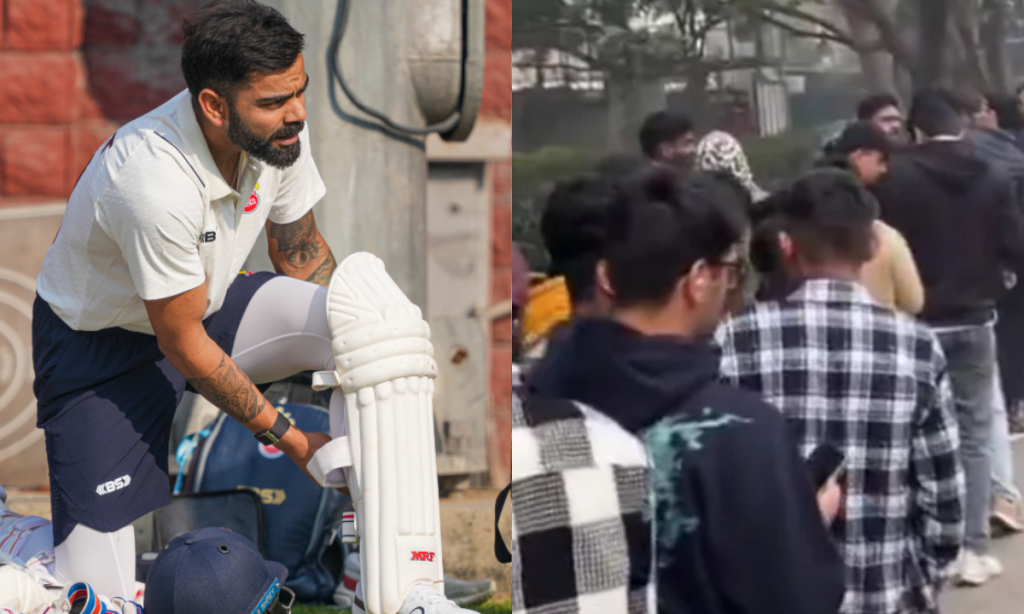The excitement was palpable as Virat Kohli, one of cricket’s modern legends, made his much-anticipated return to the Ranji Trophy after a hiatus of over a decade.
The date was January 30, 2025, and the venue was none other than the Arun Jaitley Stadium in Delhi, where Kohli was set to play against Railways in a match that had been circled on calendars by fans and cricket enthusiasts alike.
However, what was meant to be a celebration of cricket turned into a scenario of chaos and concern.
Kohli’s decision to return to the domestic circuit was driven by the need to prepare for the upcoming Champions Trophy, and his last appearance in Ranji was in 2012 against Uttar Pradesh.
Scenes Outside Gate 16: Fans Eagerly Await Glimpses of Virat Kohli
If anyone asks what Virat Kohli has earned over the years? Show them this video. UNBELIEVABLE SCENES AT ARUN JAITLEY STADIUM! 😮 #ViratRanjiComeback pic.twitter.com/LIKRqakyOv
— Prathamesh Avachare (@onlyprathamesh) January 30, 2025
The news of his participation had spread rapidly, igniting a fervor among fans who were eager to witness the maestro’s prowess in the domestic arena once again.
The anticipation was sky-high, but it wasn’t long before the excitement spiraled into disarray.
As the gates of the stadium opened on the morning of the match, the crowd’s enthusiasm overwhelmed the security measures put in place.
Fans, desperate to catch a glimpse of Kohli in action, surged forward in numbers that were unprecedented for a domestic game.
This surge led to a stampede-like situation, with people pushing and pulling in an attempt to get through the gates.
The scene was one of pandemonium.
The security personnel, although increased in number due to Kohli’s participation, were no match for the sea of humanity that descended upon the stadium. Despite their best efforts, the situation quickly spiraled out of control.
The sheer volume of fans wanting to enter led to logistical nightmares, with entry points becoming bottlenecks of human traffic.
In the chaos, several individuals were caught in the melee. Reports confirmed at least three injuries, including a security guard who was trying to manage the crowd.
A couple, caught in the crush near one of the entry points, suffered injuries; one of them needed a leg bandage after falling amidst the crowd.
The atmosphere, meant to be celebratory, was marred by these unfortunate incidents, highlighting the challenges of managing large crowds at such high-profile events.
The Delhi and District Cricket Association (DDCA) had taken measures to accommodate the unusual interest in this match.
Free entry was promised to spectators, and additional stands were opened to manage the crowd. However, the turnout was beyond all expectations.
The DDCA had communicated with Delhi Police to bolster security, but the sheer number of attendees seemed to catch everyone off-guard.
Despite the chaos, the match itself was a beacon of the game’s enduring appeal.
Kohli, playing under the captaincy of Ayush Badoni, took to the field with the same intensity and focus that has defined his career.
His presence alone was enough to turn a routine domestic match into a spectacle.
The field was a canvas where he painted strokes of brilliance, reminding everyone why he’s been a pivotal figure in Indian cricket.
The aftermath of the day’s events was reflective. While Kohli’s performance on the pitch was commendable, the incident outside raised questions about crowd management and safety protocols at sporting venues. It became clear that the allure of star players like Kohli could lead to scenarios where the infrastructure and planning might fall short.
The DDCA issued a statement post-match, expressing regret over the incidents and promising a review of their crowd management strategies.
They acknowledged the overwhelming response but emphasized the need for better preparedness to ensure the safety and enjoyment of all fans.
The broader implications of this event were not lost on the cricketing fraternity or the fans.
It was a stark reminder that while the spirit of the game can inspire awe and passion, it must be met with an equal measure of responsibility from those who organize these events.
The excitement for cricket, particularly for icons like Kohli, should not lead to harm or disrupt the very essence of what sports are meant to celebrate – unity and joy.
As Kohli continued to display his skills on the field, the incident outside the stadium served as a sobering counterpoint to the day’s sporting triumphs.
It highlighted not just the love for the game but also the urgent need for safety measures to keep pace with the growing popularity of cricket stars.
The match against Railways would be remembered not only for Kohli’s comeback but also for the lessons it offered on managing the fervor of the fans.
While Virat Kohli’s return to the Ranji Trophy was a historic moment for cricket, it was overshadowed by the chaos it inadvertently caused.
The day’s events at Arun Jaitley Stadium underscored the need for robust crowd management strategies to ensure that the passion for the game does not turn into peril for its admirers.
The spirit of cricket, embodied by players like Kohli, should inspire joy, not injury, and it’s crucial that future events reflect this ethos, ensuring safety without diminishing the excitement of the game.

